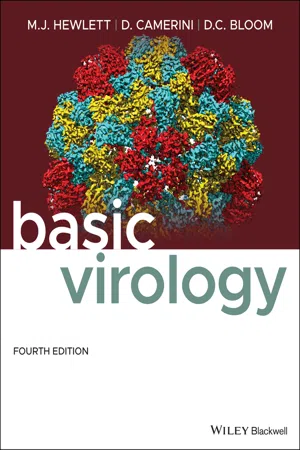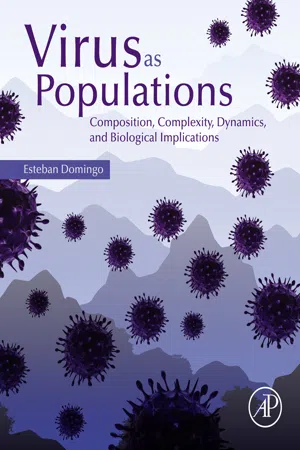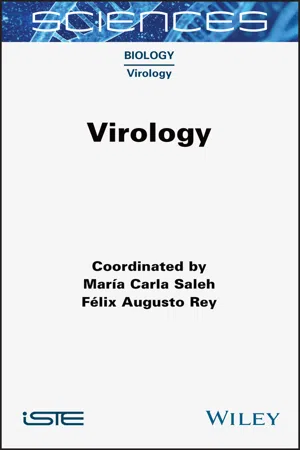Biological Sciences
Viral Genome
A viral genome refers to the complete set of genetic material (DNA or RNA) present in a virus. It contains all the information necessary for the virus to replicate and produce its proteins. Viral genomes can vary in size and structure, and they play a crucial role in the viral life cycle and interactions with host cells.
Written by Perlego with AI-assistance
Related key terms
11 Key excerpts on "Viral Genome"
- eBook - ePub
- Martinez J. Hewlett, David Camerini, David C. Bloom(Authors)
- 2021(Publication Date)
- Wiley-Blackwell(Publisher)
In essence, viruses are collections of genetic information directed toward one end: their own replication. They are the ultimate and prototypical example of “selfish genes.” The Viral Genome contains the “blueprints” for virus replication enciphered in the genetic code, and must be decoded by the molecular machinery of the cell that it infects to gain this end. Viruses are thus obligate intracellular parasites dependent on the metabolic and genetic functions of living cells.Given the essential simplicity of virus organization – a genome containing genes dedicated to self‐replication surrounded by a protective protein shell – it has been argued that viruses are nonliving collections of biochemicals whose functions are derivative and separable from the cell. Yet this generalization does not stand up to the increasingly detailed information accumulating describing the nature of viral genes, the role of viral infections in evolutionary change, and the evolution of cellular function. A view of viruses as constituting a major subdivision of the biosphere, as ancient as and fully interactive and integrated with the three great branches of cellular life, becomes more strongly established with each investigational advance.It is a major problem in the study of biology at a detailed molecular and functional level that almost no generalization is sacred, and the concept of viruses as simple parasitic collections of genes functioning to replicate themselves at the expense of the cell they attack does not hold up. Many generalizations will be made in the survey of the world of viruses introduced in this book; most if not all will be ultimately classified as being useful, but unreliable, tools for the full understanding and organization of information.Even the size range of Viral Genomes, generalized to range from one or two genes to a few hundred at most (significantly less than those contained in the simplest free‐living cells), cannot be supported by a close analysis of data. While it is true that the vast majority of viruses studied range in size from smaller than the smallest organelle to just smaller than the simplest cells capable of energy metabolism and protein synthesis, the mycoplasma and simple unicellular algae, the recently discovered mimivirus (distantly related to poxviruses such as smallpox or variola) contains nearly 1000 genes and is significantly larger than the smallest cells. With such caveats in mind, it is still appropriate to note that despite their limited size, viruses have evolved and appropriated a means of propagation and replication that ensures their survival in free‐living organisms that are generally between 10 and 10 000 000 times their size and genetic complexity. - eBook - ePub
- Roger Hull(Author)
- 2001(Publication Date)
- Academic Press(Publisher)
in vivo studies. We need to recognize the gene functions of the virus, either by direct studies on any viral proteins that can be isolated from infected cells, or by classic genetic studies that may reveal various biological activities. Finally, we need to match these viral gene activities with the functional ORFs. It is here that the techniques of reverse genetics can play a very important role. In reverse genetics, an alteration (base change, insertion or deletion of bases) is made at any preselected position in the genome. The consequences of the change are then studied with respect to its effect on the gene product and the product’s biological function, a function that may not have been previously recognized by traditional methods. However, it must be recognized that the changes could induce secondary effects on other gene products.A. Structure of the genome
There are several steps in determining the structure of a Viral Genome. The starting material is almost always nucleic acid isolated from purified virus preparations.1. Kind of nucleic acid
Whether the nucleic acid is ss or ds, DNA or RNA, or linear or circular can be established by the various chemical, physical and enzymatic procedures outlined in Chapter 4 .2. Number of genome pieces
When virus particles housing separate pieces of a multi-partite genome differ sufficiently in size or density, they may be fractionated on density gradients and the nucleic acids isolated from the fractions. Alternatively, nucleic acids of differing size may be separated on density gradients or by gel electrophoresis. When the two pieces of a bipartite genome are of very similar size, as with some geminiviruses, the existence of two distinct parts of the genome may be inferred from hybridization experiments estimating sequence complexity. However, formal proof that the genome is in two pieces of nucleic acid can best be obtained by cloning the full length of each piece separately and demonstrating that both are required for infectivity (e.g. the geminiviruses:Hamilton et al. - eBook - ePub
- David P. Clark(Author)
- 2009(Publication Date)
- Academic Cell(Publisher)
Chapter Seventeen
Viruses
Viruses are Infectious Packages of Genetic Information Life Cycle of a Virus Bacterial Viruses are Known as Bacteriophage Lysogeny or Latency by Integration The Great Diversity of Viruses Small Single-Stranded DNA Viruses of Bacteria Complex Bacterial Viruses with Double Stranded DNA DNA Viruses of Higher Organisms Viruses with RNA Genomes Have Very Few Genes Bacterial RNA Viruses Double Stranded RNA Viruses of Animals Positive-Stranded RNA Viruses Make Polyproteins Strategy of Negative-Strand RNA Viruses Plant RNA Viruses Retroviruses Use both RNA and DNA Genome of the Retrovirus Subviral Infectious Agents Satellite Viruses Viroids are Naked Molecules of Infectious RNA Prions are Infectious ProteinsViruses are Infectious Packages of Genetic Information
Viruses are packages of genes inside protective shells of protein. Viruses cannot grow or divide alone. In order to replicate, a virus must first infect a host cell. Only then are the virus genes expressed and the virus components manufactured using the host cell machinery. Viruses are not merely pieces of nucleic acid like plasmids or transposons and neither are they true living cells with the ability to generate energy and make protein. They lie in the gray area between. Viruses cannot make their own proteins or generate their own energy. They can only multiply when they have entered a suitable host cell and taken over the cellular machinery. Despite this a virus is certainly not inert; it does replicate if it can subvert a host cell.Viruses are sub-cellular parasites that rely on a cell to provide energy and raw material.Virus particles contain proteins plus genetic information in the form of DNA or RNA (Fig. 17.01 ). The virus particle, or virion , consists of a protein shell, known as a capsid , surrounding a length of nucleic acid, either RNA or DNA, which carries the virus genes and is often referred to as the Viral Genome - eBook - ePub
- Boriana Marintcheva(Author)
- 2017(Publication Date)
- Academic Press(Publisher)
The flu virus genome, for example, contains only 15,000 nucleotides. For comparison the human genome is 3,200,000,000 nucleotides or approximately 200,000 times longer. Needless to say, viruses have to be superefficient, in their quest to invade the host cell and to propagate. Bacteriophage Qβ is among the smallest RNA viruses with a genome built from 4217 nucleotides and only 4 genes. Among the smallest known animal DNA viruses is TT virus whose genome is comprised of less than 4000 nucleotides and 4 predicted genes. On the opposite side of the scale is the giant Megavirus chilensis with genome as large as 1.3 MB coding for 1000 genes. What functions Viral Genomes code for is a tantalizing question. Analysis of Viral Genome sequences revealed that approximately 80% of the Viral Genomes code for virus-specific genes, many of which have no known homologues or known function. Figure 1.6 Diversity of Viral Genomes. 1.2.3. Envelopes Viral envelopes are built from phospholipid bilayers that resemble cellular membrane. The lipid components are purely of host origin, whereas the protein components are virally coded. Most of the envelope proteins are integral glycoproteins with critical function for virus–host interactions. Similar to the proteins on the outside surface of naked viruses, they function as ligands to host receptors. Enveloped viruses acquire their envelopes as they are leaving the host cell. 1.2.4. Additional Virion Components Some enveloped viruses have distinctive protein layer spanning the space between the capsid and the envelope. In herpesviruses, this layer is named tegument, whereas in HIV and influenza a matrix (Fig. 1.5). It is thought that the extra layer is stabilizing the virion filling the gap of nonexisting direct connections between the nucleocapsid and the envelope. A small number of extra molecules are found in the virions (viral particles) of many viruses - eBook - ePub
Virus as Populations
Composition, Complexity, Dynamics, and Biological Implications
- Esteban Domingo(Author)
- 2015(Publication Date)
- Academic Press(Publisher)
Figure 1.1 ). Viruses can be divided in two broad groups: those that have RNA as genetic material, termed the RNA viruses, and those that have DNA as genetic material, termed the DNA viruses. Both groups, in turn, are subdivided in several orders, families, subfamilies, genera, species, isolates, and multitudes of variants within each isolate. The task of classifying viruses meets with considerable hurdles, and requires periodic revisions by the International Committee on Taxonomy of Viruses (ICTV). ICTV has been essential to provide conceptual order in the vast viral world. One of its objectives is the assignment of newly discovered viruses to the adequate group. A remarkable number of isolates, however, remain unclassified, an echo of the natural diversity of viruses, even among the limited subset that has been isolated and characterized.Figure 1.1 Representative average diameter values and genome complexity of viruses and some cell types. Diameters are expressed in microns (μ), length of DNA in base pairs (bp), and of RNA in nucleotides (nt). Viral Genomes can be linear, circular, segmented, or bipartite (multipartite in general; genome segments encapsidated in separate particles); in the latter case at least two particles, each with one kind of genomic segment, must infect the same cell for progeny production. The bottom boxes describe four groups of viruses according to the type of nucleic acid that acts as replicative intermediate.According to the structure of their genetic material, RNA viruses can be further subdivided into those that have either single stranded RNA (ssRNA) or double stranded RNA (dsRNA). Both can be either unsegmented RNA (one single piece of RNA) or segmented (two or more pieces or segments of RNA in a single particle or in separate particles). The viral genomic DNA, in turn, can be single stranded DNA (ssDNA) or double stranded DNA (dsDNA), and either linear or circular; in some cases the viral DNA genome is segmented (Figure 1.1 - eBook - ePub
- R C Matthews(Author)
- 2012(Publication Date)
- Academic Press(Publisher)
8 , details concerning the replication of representative virus groups and families are discussed.1 GENERAL PROPERTIES OF PLANT Viral GenomeS
1.1 INFECTIVITY OF VIRAL NUCLEIC ACIDS
A Viral Genome contains all the information necessary for the replication in vivo of complete virus particles. Whether or not a viral nucleic acid preparation will be infectious depends on two factors, physical integrity and the kind of nucleic acid.1.1.1 Physical Integrity
The genomic nucleic acid must be intact, with no phosphodiester bonds broken by physical, chemical, or enzymatic means.1.2.2 The Kind of Nucleic Acid
ss-Positive Sense RNAs
This type of genome is ready to function as a messenger RNA (mRNA) on entry into a suitable host cell, and is therefore usually infectious. However, infectivity is usually much lower than with intact virus, probably because nucleases can rapidly destroy much of the RNA. A few viruses have a small protein covalently linked to the 5ˊ end of the RNA. For some of these, the protein is essential for infectivity. A few other ss-positive sense viruses such as alfalfa mosaic virus (AMV) require the presence of coat protein or a coat protein mRNA to initiate infection.Negative Sense ssRNA Viruses
A negative sense genome has to be copied into positive sense mRNAs before it can function. This copying is carried out by a viral-coded enzyme found in the virus particle. If this is absent, the genomic RNA is noninfectious.dsRNA Viruses
Viruses with double-stranded RNA (dsRNA) genomes also contain a viral-coded enzyme, which copies the genomic RNAs into mRNAs. When the enzyme is removed during RNA isolation, the RNA becomes unable to initiate infection.DNA Viruses
Plant viruses with ds- or ssDNA genomes use host enzymes in the initial events that give rise to functional mRNAs. These DNAs are therefore able to initiate infection in the absence of virus-coded proteins. - eBook - ePub
- (Author)
- 2021(Publication Date)
- Wiley-ISTE(Publisher)
et al. 2012). These features are shared by the 100 known herpesviruses that infect invertebrates or vertebrates, eight infecting humans and two, EBV and KSHV, are considered group 1 carcinogens by the WHO. Worldwide EBV prevalence is high, greater than 90%, with the majority of infections being asymptomatic.1.3. GenomesViral Genomes encode the genes necessary for viral replication, expression, the assembly of new virions, proteins that regulate the timing of viral processes, as well as proteins that modulate host cells and promote the spread to new cells, and evasion of host cell surveillance. In addition to being single- or double-stranded, DNA virus genomes can be linear or circular, or may have more complex configurations, similar to the gapped DNA genomes of the hepadnaviruses (like HBV). Of the known viruses with linear ssDNA genomes, most are small, with lengths ranging from 4 to 12.5 kilobases, encoding less than five gene products. Those with circular ssDNA genomes range from 1.8 to 24.9 kilobases and encode less than five gene products. Those with circular dsDNA genomes can be from 4.5 to 610 kilobases in size (Hulo et al. 2011). Those with linear dsDNA Viral Genomes fall between 14.5 and 2,500 kilobases in size. Overall, linear dsDNA genomes are usually longer than ssDNA genomes and as such, encode a greater number of genes.Viral particles that carry smaller Viral Genomes tend to encode fewer genes and rely heavily on the host cell machinery for the expression and replication of their genomes. DNA viruses with large genomes are often less reliant on the host cell for replication. But all Viral Genomes, large or small, must produce mRNA that can be translated by host ribosomes.Figure 1.2.DNA Viral Genomes can be linear, circular, single- and double-stranded. In virus particles, the small double-stranded HPV genome is decorated with host histones. Certain HPV strains are known to integrate into the host genome, converting from a circular to linear integrated state. The KSHV genome in virus particles is linear; during latency, the KSHV genome becomes circularized and decorated with viral proteins and cellular histone proteins to form the KSHV episome. Created with BioRender - eBook - ePub
Viruses
Biology, Applications, and Control
- David Harper(Author)
- 2011(Publication Date)
- Garland Science(Publisher)
Even the small absolute size of many Viral Genomes is no longer always helpful and they are actually too small for many of the sequencing systems now in development. It is an unavoidable consequence of the relatively small size of virus genomes that they benefit far less from the development of the latest ultra-high-throughput systems. The often-cited lower cost of these systems may not apply for short Viral Genomes, since the actual cost per run can be high, and if the full capacity of the system is not used the cost per base can rise very significantly. It is possible to counter this by loading multiple samples in a single well, but this can cause problems if viruses are closely related, with the possibility of a single consensus sequence being generated for multiple viruses. Tagging of individual sequences may now be used to permit this. However, older systems may still be used to analyze Viral Genomes and other short nucleic acids.As of 2009, the GenBank DNA sequence database (Figure 9.3 ) contained approximately 2000 complete Viral Genome sequences (including at least one representative of every virus family known to infect humans), and many more partial sequences. However, given that the estimated number of viruses on the planet is greater than 10,000,000,000,000,000,000,000,000, 000,000 (1031 ) it is clear that we have a long way to go before we can claim to have characterized a significant percentage of viruses.As more and more sequences become available, understanding of virus function at this most basic level is increasing, with viruses previously considered to be closely related being identified as significantly different (as with hepatitis E virus, which has been moved from the Caliciviridae to its own family, the Hepeviridae) and with relationships becoming apparent that would not otherwise be detected (for example, similarities between the Herpesviridae and the tailed DNA bacteriophages).As with many systems studied, work with (relatively) simpler viral systems is likely to underpin understanding of more complex systems.Junk or not junk?
As noted, viruses have very dense coding within their genomes (sometimes exceeding 100% of the genome by the use of overlapping genes), but the human genome does not. Less than 2% of the human genome codes for proteins, prompting some observers to call the rest “junk DNA.”As is often the case, this simple and dismissive term reflects a limited understanding of a complex situation. DNA specifying many controlling factors as well as a range of non-protein effector molecules lies in these “junk” regions. These latter include the functional RNAs of the cell (transfer and ribosomal RNAs) as well as a range of small RNAs such as those of the RNAi system. Some of the DNA is likely to represent genuine “junk,” such as defunct retroviral elements (though even these may have a role, for example in moderating tolerance of fetal tissue during pregnancy), but much of it will not. - eBook - ePub
Handbook of Molecular Microbial Ecology II
Metagenomics in Different Habitats
- Frans J. de Bruijn(Author)
- 2011(Publication Date)
- Wiley-Blackwell(Publisher)
31 on planet Earth) biological entities that likely infect and disrupt all cellular organisms (see Chapters 2, 4, and 5 in this volume). Viral metagenomics, the characterization and evaluation of viral consortia from environmental samples, has shown that viruses are unexpectedly diverse. More than 5000 viral genotypes or “species” have been detected in 100 L of seawater, and ∼1 million species have been found in 1 k of sediment [Breitbart et al., 2002, 2004; Angly et al., 2006]. Viromes collected from across the world have also shown that viral species are globally distributed (everything is everywhere) but that the relative abundance of each species is restricted by local selection (for review see Srinivasiah et al. [2008] and Vega Thurber (2009)). Lastly, viromics has shown that viral functional diversity, as well as its influence on host adaptation, has been vastly underestimated (for review see Rohwer and Vega Thurber (2009)).Some physical characteristics (e.g., capsid durability) make viruses amenable to purification. However, other aspects of their biology significantly limit viral observation, maintenance, and manipulation, including: (1) the wide range of viral particle sizes, shapes, densities, and sensitivities; (2) viral decay; and (3) variation in Viral Genome type (DNA vs. RNA and single- vs. double-stranded) and length. For example, some archaeal and eukaryotic viruses (e.g., fuselloviruses, asfraviruses, and iridoviruses) can withstand temperatures above 55°C for extended periods of time [Fauquet et al., 2005]; but depending on the prevailing abiotic and biotic conditions, some marine viral particles decay on the order of hours (∼2.5–12 h) to days [Suttle and Feng, 1992].Additionally, the majority of viruses cannot be grown in pure culture because their hosts are recalcitrant to cultivation. The lack of a single phylogenetic marker amongst viral families requires that alternative approaches to gene marker-based phylogenetics (e.g., the 16S rRNA gene sequence commonly used for Bacteria and Archaea; see Chapter 15, Vol. I) be used for the evaluation of viral consortia in environmental samples [Rohwer and Edwards, 2002]. Finally, the disparate phenetic parameters (e.g., genome type, host range, and morphological and physical characteristics, as well as genetic and genomic sequence similarities) used in viral taxonomy have generated polyphyletic viral families and obscured the evolutionary relationships between taxa and sequences [Lawrence et al., 2002]. Therefore, any researcher interested in generating and analyzing viromes must confront a suite of both methodological and analytical challenges. - eBook - ePub
Monographs in Population Biology
Dynamics of Viruses and Their Microbial Hosts
- Joshua S. Weitz(Author)
- 2016(Publication Date)
- Princeton University Press(Publisher)
These discoveries are ongoing. Indeed, in 2014 a French team of researchers reported the discovery of giant viruses related to the mimivirus family. These viruses were frozen in the Siberian tundra for more than 30,000 years, were revived, and still retained the ability to infect extant amoeba cells (Legendre et al. 2014). There is evidently more to discover on all three components of viral diversity outlined in this chapter. To understand the ecological role of viruses requires moving outward, from virus particles to virus–host interactions. That is the subject of Chapter 2. 1.3 SUMMARY • The study of virology is relatively recent. The conclusive discovery that viruses were a causative agent of infection in plants, animals, and microbes was not made until the advent of electron microscopy in the 1930s. • Viruses vary in size from genomes of a few thousand to more than a million nucleotides. • Viral capsids vary in linear dimensions from approximately 20 nm to more than 400 nm in diameter. • The elemental composition of viruses can be predicted based on simple scaling arguments. • Virus particles are relatively nutrient rich compared with their hosts. • Viral Genomes are compact, with the number of putative genes scaling linearly with genome size. • The functional diversity of viruses includes many canonical viral genes, such as those that code for capsid proteins and transcriptional regulators. • The functional diversity of viruses includes many noncanonical genes, such as those that code for proteins that are part of photosystem pathways or cell-wall pathways. 1 An old joke about physicists and spherical cows comes to mind; here it seems to apply to physiologists and spherical dogs. Nonetheless, such spheres are not a bad starting point. CHAPTER TWO Viral Life History Traits 2.1 LIFE HISTORY TRAITS IN ECOLOGY The primary aim of this chapter is to introduce a number of key commonalities and differences among viral life history traits - eBook - ePub
- Roger Hull(Author)
- 2013(Publication Date)
- Academic Press(Publisher)
Dunigan et al., 1988 ) or even be encapsidated.b Classic Viral Genetics
Two kinds of classic genetic study have identified many biological activities of Viral Genomes, and both of these procedures are still useful in appropriate circumstances.i Allocation of Functions in Multiparticle VirusesThe discovery of viruses with the genome divided between two or three particles opened up the possibility of locating specific functions on particular RNA species. The requirements for, and stages in, this kind of analysis are: (i) purification of the virus; (ii) fractionation of the genome components, either as nucleoprotein particles (on density gradients of sucrose or cesium salts) or as isolated biologically active RNA species (usually by electrophoresis on polyacrylamide gels); (iii) definition of the set of RNA molecules that constitute the minimum Viral Genome; (iv) identification and isolation of natural strains or artificial mutants differing in some defined biological or physical properties, which will provide suitable experimental markers. For example, Dawson (1978) isolated a set of ts mutants of CMV. One group of mutations mapped on RNA3 and the rest on RNA1; (v) in vitro substitution of components from different strains or mutants in various combinations. These are inoculated to appropriate host plant species. The relevant biological or physical properties of the various combinations are determined. A particular property may then be allocated to a particular genome segment or segments; (vi) back-mixing experiments. In such experiments, the parental genome pieces are isolated from the artificial hybrids, mixed in the original combinations, and tested for appropriate physical or biological properties. Such tests are necessary to show that the RNAs of the hybrids retain their identity during replication; (vii) supplementation tests. These tests provide an alternative procedure to in vitro reassortment. Individual wild-type genome segments are added to a defective (mutant) inoculum. Restoration of the wild-type character in a particular mixture will indicate which segment controls the character (Dawson, 1978
Index pages curate the most relevant extracts from our library of academic textbooks. They’ve been created using an in-house natural language model (NLM), each adding context and meaning to key research topics.










